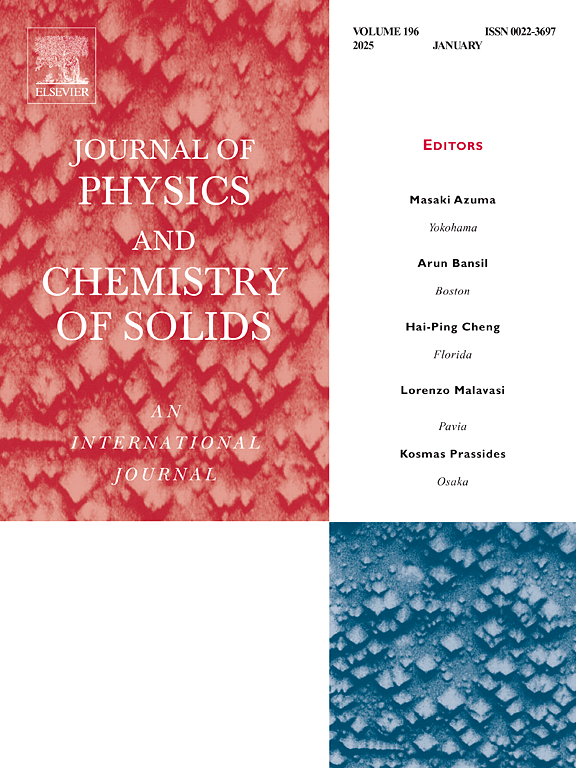Mechanochemical synthesis of AgI–BiOI@g-C3N4 heterojunction for the efficient degradation of cationic dye RhB under visible light irradiation
IF 4.9
3区 材料科学
Q2 CHEMISTRY, MULTIDISCIPLINARY
引用次数: 0
Abstract
The direct release of large quantities of textile dyes into natural water highlights the urgent need for effective pollution treatment strategies. In this situation, photodegradation emerges as a crucial and environmentally friendly technique for protecting the environment. In this study, a simple mechanochemical synthesis protocol was used for the preparation of a heterojunction based on the combination of AgI–BiOI and g-C3N4. The heterojunction was characterized using X-ray Diffraction (XRD), Scanning Electron Microscopy combined with Energy Dispersive X-ray Spectroscopy (SEM/EDX), Fourier Transform Infrared Spectroscopy (FTIR), and Diffuse Reflectance Spectroscopy (DRS). The results of these studies demonstrated the successful formation of the heterojunction, which had excellent structural, textural, and optical properties. To better understand the degradation process of RhB dye over the photocatalyst, a thorough investigation of key parameters such as catalyst dosage, pH, initial dye concentration, scavenger, and reutilization was carried out. The heterojunction with the ratio (AgI–BiOI/g-C3N4 = 0.8) demonstrated remarkable efficiency in the degradation of RhB dye. Notably, the apparent degradation rate was found to be 14.5 times greater than that reached with the g-C3N4 alone. This significant enhancement in degradation performance suggests the potential of the synthesized heterojunction as an effective catalyst for environmental remediation applications.

机械化学合成AgI - BiOI@g-C3N4异质结在可见光下高效降解阳离子染料RhB
大量纺织染料直接排放到自然水体中,迫切需要有效的污染处理策略。在这种情况下,光降解成为保护环境的关键和环保技术。在本研究中,采用简单的机械化学合成方案制备了基于AgI-BiOI和g-C3N4结合的异质结。采用x射线衍射(XRD)、扫描电镜结合能量色散x射线能谱(SEM/EDX)、傅里叶变换红外光谱(FTIR)和漫反射光谱(DRS)对异质结进行了表征。这些研究结果证明了异质结的成功形成,该异质结具有优异的结构、纹理和光学性能。为了更好地了解RhB染料在光催化剂上的降解过程,对催化剂用量、pH、染料初始浓度、清除剂和再利用等关键参数进行了深入的研究。AgI-BiOI /g-C3N4 = 0.8的异质结对RhB染料的降解效果显著。值得注意的是,表观降解率是单独使用g-C3N4的14.5倍。这一显著提高的降解性能表明,合成的异质结作为环境修复应用的有效催化剂的潜力。
本文章由计算机程序翻译,如有差异,请以英文原文为准。
求助全文
约1分钟内获得全文
求助全文
来源期刊
CiteScore
7.80
自引率
2.50%
发文量
605
审稿时长
40 days
期刊介绍:
The Journal of Physics and Chemistry of Solids is a well-established international medium for publication of archival research in condensed matter and materials sciences. Areas of interest broadly include experimental and theoretical research on electronic, magnetic, spectroscopic and structural properties as well as the statistical mechanics and thermodynamics of materials. The focus is on gaining physical and chemical insight into the properties and potential applications of condensed matter systems.
Within the broad scope of the journal, beyond regular contributions, the editors have identified submissions in the following areas of physics and chemistry of solids to be of special current interest to the journal:
Low-dimensional systems
Exotic states of quantum electron matter including topological phases
Energy conversion and storage
Interfaces, nanoparticles and catalysts.

 求助内容:
求助内容: 应助结果提醒方式:
应助结果提醒方式:


